 W
WIn evolutionary biology, mimicry is an evolved resemblance between an organism and another object, often an organism of another species. Mimicry may evolve between different species, or between individuals of the same species. Often, mimicry functions to protect a species from predators, making it an anti-predator adaptation. Mimicry evolves if a receiver perceives the similarity between a mimic and a model and as a result changes its behaviour in a way that provides a selective advantage to the mimic. The resemblances that evolve in mimicry can be visual, acoustic, chemical, tactile, or electric, or combinations of these sensory modalities. Mimicry may be to the advantage of both organisms that share a resemblance, in which case it is a form of mutualism; or mimicry can be to the detriment of one, making it parasitic or competitive. The evolutionary convergence between groups is driven by the selective action of a signal-receiver or dupe. Birds, for example, use sight to identify palatable insects and butterflies, whilst avoiding the noxious ones. Over time, palatable insects may evolve to resemble noxious ones, making them mimics and the noxious ones models. In the case of mutualism, sometimes both groups are referred to as "co-mimics". It is often thought that models must be more abundant than mimics, but this is not so. Mimicry may involve numerous species; many harmless species such as hoverflies are Batesian mimics of strongly defended species such as wasps, while many such well-defended species form Müllerian mimicry rings, all resembling each other. Mimicry between prey species and their predators often involves three or more species.
 W
WAdaptive Coloration in Animals is a 500-page textbook about camouflage, warning coloration and mimicry by the Cambridge zoologist Hugh Cott, first published during the Second World War in 1940; the book sold widely and made him famous.
 W
WAggressive mimicry is a form of mimicry in which predators, parasites, or parasitoids share similar signals, using a harmless model, allowing them to avoid being correctly identified by their prey or host. Zoologists have repeatedly compared this strategy to a wolf in sheep's clothing. In its broadest sense, aggressive mimicry could include various types of exploitation, as when an orchid exploits a male insect by mimicking a sexually receptive female, but will here be restricted to forms of exploitation involving feeding. An alternative term Peckhamian mimicry has been suggested, but is seldom used. For example, indigenous Australians who dress up as and imitate kangaroos when hunting would not be considered aggressive mimics, nor would a human angler, though they are undoubtedly practising self-decoration camouflage. Treated separately is molecular mimicry, which shares some similarity; for instance a virus may mimic the molecular properties of its host, allowing it access to its cells.
 W
WAnimal coloration is the general appearance of an animal resulting from the reflection or emission of light from its surfaces. Some animals are brightly coloured, while others are hard to see. In some species, such as the peafowl, the male has strong patterns, conspicuous colours and is iridescent, while the female is far less visible.
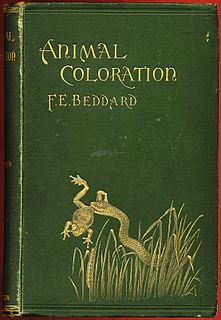 W
WAnimal Coloration, or in full Animal Coloration: An Account of the Principal Facts and Theories Relating to the Colours and Markings of Animals, is a book by the English zoologist Frank Evers Beddard, published by Swan Sonnenschein in 1892. It formed part of the ongoing debate amongst zoologists about the relevance of Charles Darwin's theory of natural selection to the observed appearance, structure, and behaviour of animals, and vice versa.
 W
WAnt mimicry or myrmecomorphy is mimicry of ants by other organisms. Ants are abundant all over the world, and potential predators that rely on vision to identify their prey, such as birds and wasps, normally avoid them, because they are either unpalatable or aggressive. Spiders are the most common ant mimics. Additionally, some arthropods mimic ants to escape predation, while others mimic ants anatomically and behaviourally to hunt ants in aggressive mimicry. Ant mimicry has existed almost as long as ants themselves; the earliest ant mimics in the fossil record appear in the mid Cretaceous alongside the earliest ants. Indeed one of the earliest, Burmomyrma, was initially classified as an ant.
 W
WIn zoology, automimicry, Browerian mimicry, or intraspecific mimicry, is a form of mimicry in which the same species of animal is imitated. There are two different forms.
 W
WBatesian mimicry is a form of mimicry where a harmless species has evolved to imitate the warning signals of a harmful species directed at a predator of them both. It is named after the English naturalist Henry Walter Bates, after his work on butterflies in the rainforests of Brazil.
 W
WOperation Bertram was a Second World War deception operation practised by the Allied forces in Egypt led by Bernard Montgomery, in the months before the Second Battle of El Alamein in 1942. Bertram was devised by Dudley Clarke to deceive Erwin Rommel about the timing and location of the Allied attack. The operation consisted of physical deceptions using dummies and camouflage, designed and made by the British Middle East Command Camouflage Directorate led by Geoffrey Barkas. These were accompanied by electromagnetic deceptions codenamed Operation Canwell, using false radio traffic. All of these were planned to make the Axis believe that the attack would take place to the south, far from the coast road and railway, about two days later than the real attack.
 W
WBioluminescence is the production and emission of light by a living organism. It is a form of chemiluminescence. Bioluminescence occurs widely in marine vertebrates and invertebrates, as well as in some fungi, microorganisms including some bioluminescent bacteria, and terrestrial arthropods such as fireflies. In some animals, the light is bacteriogenic, produced by symbiotic bacteria such as those from the genus Vibrio; in others, it is autogenic, produced by the animals themselves.
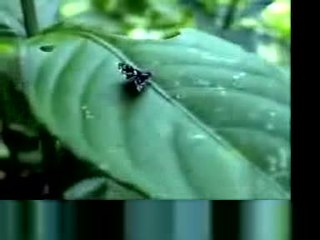 W
WBrenthia hexaselena is a species of moth of the family Choreutidae. It is found in Costa Rica. It is a rare example of a prey animal mimicking its predator.
 W
WCamouflage is the use of any combination of materials, coloration, or illumination for concealment, either by making animals or objects hard to see, or by disguising them as something else. Examples include the leopard's spotted coat, the battledress of a modern soldier, and the leaf-mimic katydid's wings. A third approach, motion dazzle, confuses the observer with a conspicuous pattern, making the object visible but momentarily harder to locate. The majority of camouflage methods aim for crypsis, often through a general resemblance to the background, high contrast disruptive coloration, eliminating shadow, and countershading. In the open ocean, where there is no background, the principal methods of camouflage are transparency, silvering, and countershading, while the ability to produce light is among other things used for counter-illumination on the undersides of cephalopods such as squid. Some animals, such as chameleons and octopuses, are capable of actively changing their skin pattern and colours, whether for camouflage or for signalling. It is possible that some plants use camouflage to evade being eaten by herbivores.
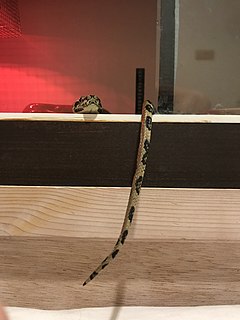 W
WCaudal luring is a form of aggressive mimicry characterized by the waving or wriggling of the predator's tail to attract prey. This movement attracts small animals who mistake the tail for a small worm or other small animal. When the animal approaches to prey on the worm-like tail, the predator will strike. This behavior has been recorded in snakes, sharks, and eels.
 W
WChemical mimicry is a type of biological mimicry, involving the use of chemicals to dupe an operator. A chemical mimic dupes an operator by showing an adaptive chemical resemblance to an object of its environment and as a consequence receives selective advantage. In all cases of chemical mimicry it has been found that the mimicking species is the only species to benefit from the reaction with either costs or no effect on the duped species. This is by adapting to produce chemicals that will cause a desirable behavioural reaction in the species being deceived and a selective advantage to the mimic. Chemical mimicry exists within many of the different forms of mimicry such as aggressive, protective, Batesian, and Müllerian mimicry and can involve a number of different senses. Mimicking semiochemicals, which cannot be seen, make up some of the most widely used forms of chemical mimicry and is therefore less apparent than more visual forms. As a result of this, this topic has been relatively neglected in research and literature. Two examples of organisms displaying chemical mimicry include the mimicking of Noctuid pheromones by bolas spiders in order to draw prey to the spider’s location and the duping of insects within their own nests by mimicking their odours in order to enter and hide within the nest undetected. It is important to note that in all forms of mimicry the mimicking organism is not conscious of the deceit used and does not act intentionally to trick other organisms.
 W
WAnimal coloration provided important early evidence for evolution by natural selection, at a time when little direct evidence was available. Three major functions of coloration were discovered in the second half of the 19th century, and subsequently used as evidence of selection: camouflage ; mimicry, both Batesian and Müllerian; and aposematism.
 W
WThe Colours of Animals is a zoology book written in 1890 by Sir Edward Bagnall Poulton (1856–1943). It was the first substantial textbook to argue the case for Darwinian selection applying to all aspects of animal coloration. The book also pioneered the concept of frequency-dependent selection and introduced the term "aposematism".
 W
WIn ecology, crypsis is the ability of an animal or a plant to avoid observation or detection by other animals. It may be a predation strategy or an antipredator adaptation. Methods include camouflage, nocturnality, subterranean lifestyle and mimicry. Crypsis can involve visual, olfactory, or auditory concealment. When it is visual, the term cryptic coloration, effectively a synonym for animal camouflage, is sometimes used, but many different methods of camouflage are employed by animals or plants.
 W
WEmsleyan mimicry, also called Mertensian mimicry, describes an unusual type of mimicry where a deadly prey mimics a less dangerous species.
 W
WAn eyespot is an eye-like marking. They are found in butterflies, reptiles, cats, birds and fish.
 W
WFlower mantises are praying mantis species that display behaviors of mimicry. These insects have specific colorations and behaviors that mimic flowers in their surrounding habitats. The flower mantises are non-nocturnal group with a single ancestry, but the majority of the known species belong to family Hymenopodidea. These animals use a special form of camouflage referred to as Aggressive mimicry, which is used not only to avoid predation but to attract prey as well. This strategy has been observed in other mantises including the stick mantis and dead-leaf mantis. The observed behavior of these mantises includes positioning themselves on a plant and either inserting themselves within the irradiance or on the foliage of the plants until a prey species comes within range. Many species of flower mantises are popular as pets.
 W
WThe hornet moth or hornet clearwing is a large moth native to Europe and the Middle East and has been introduced to North America. Its protective coloration is an example of Batesian mimicry, as its similarity to a hornet makes it unappealing to predators. The hornet moth has been linked to the large dieback of poplar trees across Europe because its larvae bore into the trunk of the tree before re-emerging as adults.
 W
WLingual luring is a form of aggressive mimicry in which a predator uses its tongue to fool potential prey into approaching close to what appears to be a small wriggling worm.
 W
WA lyrebird is either of two species of ground-dwelling Australian birds that compose the genus Menura, and the family Menuridae. They are most notable for their superb ability to mimic natural and artificial sounds from their environment, and the striking beauty of the male bird's huge tail when it is fanned out in courtship display. Lyrebirds have unique plumes of neutral-coloured tailfeathers and are among Australia's best-known native birds.
 W
WIn evolutionary biology, mimicry in plants is where a plant organism evolves to resemble another organism physically or chemically, increasing the mimic's Darwinian fitness. Mimicry in plants has been studied far less than mimicry in animals, with fewer documented cases and peer-reviewed studies. However, it may provide protection against herbivory, or may deceptively encourage mutualists, like pollinators, to provide a service without offering a reward in return.
 W
WMisumena vatia is a species of crab spider with a holarctic distribution. In North America, it is called the goldenrod crab spider or flower (crab) spider, as it is commonly found hunting in goldenrod sprays and milkweed plants. They are called crab spiders because of their unique ability to walk sideways as well as forwards and backwards. Both males and females of this species progress through several molts before reaching their adult sizes, though females must molt more to reach their larger size. Females can grow up to 10 mm (0.39 in) while males are quite small, reaching 5 mm (0.20 in) at most. Misumena vatia are usually yellow or white or a pattern of these two colours. They may also present with pale green or pink instead of yellow, again, in a pattern with white. They have the ability to change between these colors based on their surroundings with these color changes occur through the molting process. They have a complex visual system, with eight eyes, that they rely on for prey capture and for their color-changing abilities. Sometimes, if Misumena vatia consume colored prey, the spider itself will take on that color.
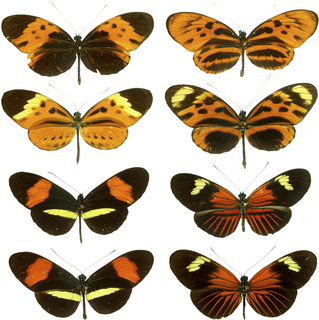 W
WMüllerian mimicry is a natural phenomenon in which two or more well-defended species, often foul-tasting and that share common predators, have come to mimic each other's honest warning signals, to their mutual benefit. This works because predators can learn to avoid all of them with fewer experiences with members of any one of the relevant species. It is named after the German naturalist Fritz Müller, who first proposed the concept in 1878, supporting his theory with the first mathematical model of frequency-dependent selection, one of the first such models anywhere in biology.
 W
WMyrmecoris gracilis is a species of flightless Hemipteran bug from the family Miridae. The genus Mymecoris is monotypic with one Palaearctic species. It differs in its outward appearance and way of life from other "grass bugs" in the Stenodemini, being predatory and an effective ant mimic.
 W
WParaplectana tsushimensis is a spider in the orb-weaver family, Araneidae, native to China, Japan, and Taiwan. It is commonly called the ladybird mimic spider.
 W
WPhagomimicry is a defensive behaviour of sea hares, in which the animal ejects a mixture of chemicals, which mimic food, and overwhelm the senses of their predator, giving the sea hare a chance to escape. The typical defence response of the sea hare to a predator is to release two chemicals - ink from the ink gland and opaline from the opaline gland. While ink creates a dark, diffuse cloud in the water which disrupts the sensory perception of the predator by acting as a smokescreen and as a decoy, the opaline, which affects the senses dealing with feeding, causes the predator to instinctively attack the cloud of chemicals as if it were indeed food. This ink is able to mimic food by having a high concentration of amino acids and other compounds that are normally found in food, and the attack behaviour of the predator allows the sea-hares the opportunity to escape.
 W
WPseudocopulation describes behaviors similar to copulation that serve a reproductive function for one or both participants but do not involve actual sexual union between the individuals. It is most generally applied to a pollinator attempting to copulate with a flower. Some flowers mimic a potential female mate visually, but the key stimuli are often chemical and tactile. This form of mimicry in plants is called Pouyannian mimicry.
 W
WSacoproteus is a genus of sea slugs in the Limapontiidae family, described in 2018. It contains five species, of which four were newly described when the genus was erected, and one was reassigned from its previous classification of Stiliger smaragdinus as the type species of the new genus. Most of the species are mimetic of toxic "sea-grape" algae in the genus Caulerpa.
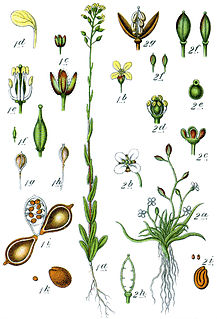 W
WIn plant biology, Vavilovian mimicry is a form of mimicry in plants where a weed evolves to share one or more characteristics with a domesticated plant through generations of artificial selection. It is named after Nikolai Vavilov, a prominent Russian plant geneticist. Selection against the weed may occur by killing a young or adult weed, separating its seeds from those of the crop (winnowing), or both. This has been done manually since Neolithic times, and in more recent years by agricultural machinery.
 W
WMichael Leslie Winslow is an American actor, comedian and beatboxer billed as The Man of 10,000 Sound Effects for his ability to make realistic sounds using only his voice. He is best known for his roles in all seven Police Academy films as Larvell Jones. He has also appeared in Spaceballs, Cheech and Chong's Next Movie and Nice Dreams, The Love Boat, and commercials for Cadbury and GEICO.